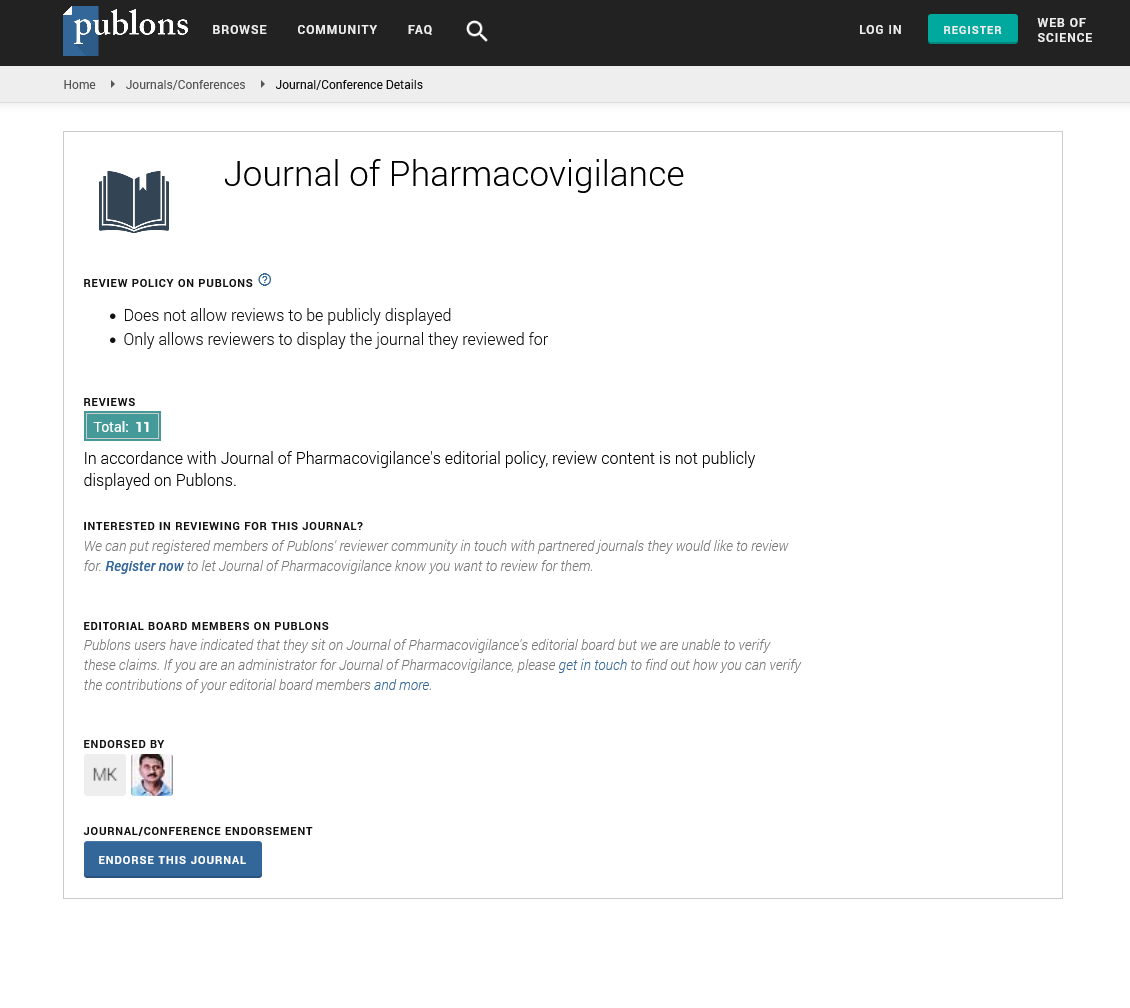Indexed In
- Open J Gate
- JournalTOCs
- The Global Impact Factor (GIF)
- RefSeek
- Hamdard University
- EBSCO A-Z
- OCLC- WorldCat
- Publons
- Euro Pub
- Google Scholar
Useful Links
Share This Page
Journal Flyer

Open Access Journals
- Agri and Aquaculture
- Biochemistry
- Bioinformatics & Systems Biology
- Business & Management
- Chemistry
- Clinical Sciences
- Engineering
- Food & Nutrition
- General Science
- Genetics & Molecular Biology
- Immunology & Microbiology
- Medical Sciences
- Neuroscience & Psychology
- Nursing & Health Care
- Pharmaceutical Sciences
Perspective - (2022) Volume 10, Issue 7
Pharmacoepidemological Challenges in Rare Diseases
Junyan Wu*Received: 03-Jun-2022, Manuscript No. JP-22-17783; Editor assigned: 06-Jun-2022, Pre QC No. JP-22-17783(PQ); Reviewed: 20-Jun-2022, QC No. JP-22-17783; Revised: 27-Jun-2022, Manuscript No. JP-22-17783(R); Published: 07-Jul-2022, DOI: 10.35248/2329-6887.22.10.381
Description
Pharmacoepidemiology is the application of epidemiological principles and methods to the study of the effects of drugs in human populations. The goal of this field is to characterize, control and predict the efficacy and application of pharmacological therapeutics.
Pharmacoepidemiology also addresses the economic impact and health benefits of unintended drug reactions. Pharmacoepidemiology is gaining in importance because of the need to better understand how drugs are used in the general population. Casecontrol and cohort studies enable researchers to assess the impact of patient variables on clinical outcomes and provide a wealth of resources for studying unanticipated drug effects, drug use, treatment costs, and individualization of treatment.
Interest in pharmacoepidemiology is growing because the Randomized Controlled Trials (RCTs) used for registration purposes are generally too weak to provide a safety signal for rare events. Furthermore, for operational or ethical reasons, it is not feasible to conduct RCTs in special populations, such as very old or very young, and of sufficient duration to capture all safety endpoints. Advances in pharmacoepidemiology have not only overcome limitations of generalization but also increased followup time for investigating rare adverse events.
Scope of pharmacoepidemiology
Pharmacoepidemiology welcomes manuscripts covering a wide range of areas including, but not limited to:
1. Drafts, analyses, results, and interpretations of research on pharmaceuticals, biologics, or medical devices.
2. Molecular pharmacoepidemiology
3. Pharmacoepidemiological methodology
4. Pharmacovigilance
5. Patient safety
6. Patterns of drug use
7. Post-market surveillance
8. Pharmacoeconomics
9. Development and interpretation of regulatory guidelines
10. Studies of the benefits/safety/efficacy of drugs, biologics, or medical devices
11. Evaluation of the benefits and harms of drug therapy
12. Evaluation of pharmaceutical, biological and medical device risk management plans
The goal of pharmacoepidemiology during the pre-approval drug development stage is to better understand the target population and indication. In this sense, it is very useful to determine which segments of the target population are included in the clinical trial program and which segments of the population may require additional follow-up after approval. During development, pharmacoepidemiology studies should be used to identify major comorbidities of the underlying disease and the association of the experimental drug with these comorbidities.
Pharmacoepidemiology is a novel approach to understanding drug use in large populations, identifying and quantifying adverse drug reactions in populations, and quantifying the risks or benefits of taking drugs for specific diseases or conditions. Secondary data is becoming increasingly available as medical records and claims processes become more electronic. Pharmacoepidemiology has established robust study designs that provide strong evidence for drug-outcome relationships. Pharmacoepidemiological results can be used in combination with other data to explain or identify areas of need and improve health outcomes.
The importance of pharmacoepidemiology is underscored by the large number of unresolved drug withdrawals in recent years. These withdrawals were preceded by serious or fatal side effects that were unrecognized or underestimated at the time of approval. Pharmacoepidemiological tools can be used to detect side effects that are overlooked in random studies as a result of these side effects like risk of infarction and stroke in older patients. This occurs primarily in patient teams that are underrepresented in clinical studies e.g., and/or primarily in patients with certain comorbidities or genotypes.
Knowledge of pharmacoepidemiology is essential in today's era of big data. Practitioners involved in the proper handling of pharmaceuticals. This corresponds to the WHO definition
Pharmacoepidemiology: The study of drug use and effects/side effects in large doses people with the purpose of supporting the rational and cost-effective use of medicines in the population thereby improving health outcomes.
Citation: Wu J (2022) Pharmacoepidemological Challenges in Rare Diseases. J Pharmacovigil. 10:381.
Copyright: © 2022 Wu J. This is an open-access article distributed under the terms of the Creative Commons Attribution License, which permits unrestricted use, distribution, and reproduction in any medium, provided the original author and source are credited.

